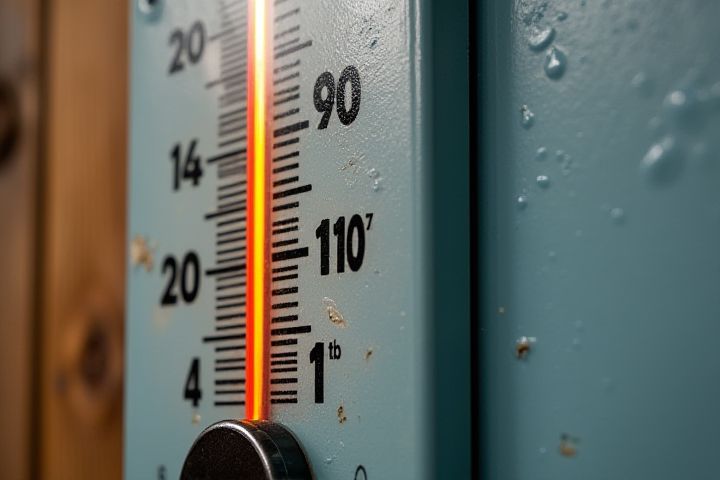
House temperatures fluctuate due to various factors including weather changes, insulation quality, and heating or cooling system efficiency. External weather conditions, such as shifts in outdoor temperature or humidity levels, directly impact indoor climate. Poor insulation can lead to heat loss during winter and heat gain in summer, causing inconsistent temperatures. The performance of heating and cooling systems also plays a crucial role; malfunctioning or outdated units may struggle to maintain a stable temperature. Weatherstripping and window treatments can help regulate indoor temperatures, ensuring a more comfortable living environment.
Why House Temperatures Fluctuate
Insulation quality
Insulation quality significantly impacts your home's temperature stability, as it determines how effectively the property retains heat during colder months and keeps it cool in summer. Homes with superior insulation can reduce energy consumption by up to 30%, leading to lower utility bills and a more comfortable living environment. Poor insulation results in heat loss during winter and heat gain during summer, often causing fluctuations ranging from 5degF to 15degF. Investing in high-quality insulation materials, such as spray foam or fiberglass, can greatly enhance your home's energy efficiency and indoor climate control.
Outdoor weather changes
Outdoor weather changes significantly impact house temperatures, primarily through factors like sunlight, wind, and humidity. For instance, a sudden drop in temperature during nighttime can lead to a rapid decrease in indoor warmth, particularly in poorly insulated homes. During summer, a peak temperature of 95degF outside can escalate the indoor temperature, especially if windows are left uncovered, causing discomfort. Understanding these fluctuations can help you take appropriate measures to maintain a stable indoor climate, such as using shades or adjusting heating systems based on current weather conditions.
HVAC system efficiency
House temperatures fluctuate primarily due to the efficiency of the HVAC system, which operates at an average efficiency rating of 15 SEER (Seasonal Energy Efficiency Ratio). Poor insulation, inadequate ductwork, and aging equipment can significantly hinder performance, causing temperature variations of up to 5-10 degrees Fahrenheit within the same space. Regular maintenance tasks, such as changing air filters every 1-3 months and scheduling annual professional inspections, can improve HVAC efficiency by as much as 20%. By addressing these factors, you can create a more consistent indoor climate and potentially reduce energy bills by 10-30%.
Sunlight exposure
Sunlight exposure significantly impacts house temperatures, causing noticeable fluctuations throughout the day. In rooms that receive direct sunlight, temperatures can rise rapidly, creating a warm and inviting atmosphere during the day. Conversely, shaded areas may remain cool, particularly in the early morning or late afternoon. By managing window coverings or utilizing reflective materials, you can effectively regulate indoor temperatures, creating a more comfortable living environment.
Window types and seals
House temperatures fluctuate significantly due to variations in window types and their seals. Single-pane windows offer minimal insulation, allowing for a heat transfer rate of about 1.0 to 1.5 U-value per square foot, which results in increased energy loss. In contrast, double-pane windows, with U-values ranging from 0.3 to 0.5, provide better thermal resistance, reducing temperature swings. Poorly maintained or outdated window seals can exacerbate these fluctuations, leading to drafts and compromised energy efficiency, often increasing your heating and cooling costs by as much as 25%.
Air leaks or drafts
Air leaks and drafts can significantly contribute to temperature fluctuations within your house, compromising comfort and energy efficiency. These leaks often occur around windows, doors, and inadequate insulation, allowing conditioned air to escape and outdoor air to infiltrate. When the temperature outside changes, these drafts cause heating and cooling systems to work harder, leading to inconsistent indoor temperatures and increased energy bills. To mitigate this issue, sealing gaps and ensuring proper insulation is crucial in maintaining a stable and comfortable environment in your home.
Thermostat placement
Improper thermostat placement significantly contributes to fluctuations in house temperatures. When a thermostat is located near heat sources, such as windows or appliances, it can inaccurately gauge the ambient temperature, leading to premature cycling of the heating or cooling system. Conversely, placing a thermostat in drafty areas can prevent it from detecting the true temperature, resulting in uneven heating or cooling throughout your space. To ensure optimal performance, consider the ideal placement of your thermostat, ideally on an interior wall, away from direct sunlight or airflow interference.
Humidity levels
Humidity levels play a crucial role in the fluctuation of house temperatures, as they directly impact how heat is retained or lost in your living space. High humidity can make warm air feel even hotter, causing you to rely more on air conditioning, which may lead to drastic temperature changes when the system cycles on or off. Conversely, low humidity can lead to dry air, resulting in quicker heat loss and making spaces feel cooler than they actually are. By managing humidity with dehumidifiers or humidifiers, you can create a more stable indoor environment that reduces temperature swings and enhances comfort.
Appliance heat output
Appliance heat output plays a significant role in causing fluctuations in house temperatures. Everyday devices, such as ovens, dryers, and heaters, generate heat during operation, which can temporarily raise the indoor temperature. Conversely, when these appliances are turned off, the ambient temperature may drop, leading to thermal instability within your living space. Understanding how the heat output from various appliances impacts your home's climate can help you manage energy efficiency and comfort levels effectively.
Building materials used
House temperatures fluctuate primarily due to the thermal properties of building materials. Materials such as wood, concrete, and metal all have different heat retention capacities, affecting how quickly or slowly a home absorbs and releases heat. For instance, homes built with high-density materials like brick may maintain temperature more effectively than those constructed with lighter materials, leading to a more stable indoor environment. Understanding these variations can help you select appropriate insulation and construction methods, significantly improving your home's energy efficiency and reducing heating and cooling costs.
